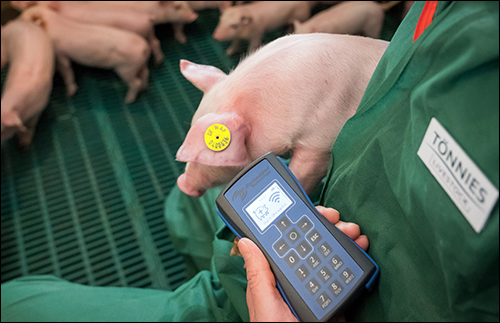Radio frequency identification provides an opportunity for the food industry to better monitor the health of animals and the storage of meat before it is provided to consumers. With that in mind, German food industry company Tönnies Livestock‘s business group has developed an ultrahigh-frequency (UHF) system for tracking pigs using a passive RFID-enabled ear tag and readers, as well as its own software to manage the collected data.
Tönnies has been piloting the technology with swine breeder and genetics firm Topigs Norsvin since February 2016, and intends to complete the pilot next month. The organization has already been using RFID as part of its fTrace system which captures and stores data related to the slaughtering of a pig and provides that data to customers. The new RFID data, on the other hand, looks back to the earliest days of the pig’s life, by tracking the animal from the breeder to the slaughterhouse. The RFID data is being captured and stored on IQ-Agrar Service GmbH IQ-cloud-based software.
Tönnies Livestock, a subsidiary company within the Tönnies Group, manages the supply of pigs to Tönnies’ slaughterhouses, according to customer specifications and needs. Tönnies Livestock works with a variety of farms and producers, and oversees data management related to the breeding and fattening of pigs. Tönnies’ business group is tasked with developing new technologies that advance the production and marketing of meat products.
The business group has been using RFID-enabled slaughter-hooks since the late 1990s as part of its fTrace program, and has refined the data collection at the point of slaughtering throughout the years. The data collected is used to create a pig ID card that contains such information as where the animal is from, when and where it was slaughtered, and when and where the shelf-read product was manufactured and packed.
With the more recently launched RFID pilot, the focus is on the life of the pig, in order to assist with the basic supply chain. The data is intended to be shared with breeding organizations, piglet producers, fatteners, slaughterhouses and marketers. For producers, the data (such as the animal’s weight at birth) can help them understand the pig’s entire life cycle and, therefore, how to improve the production or fattening processes. Tönnies Livestock and marketers can use this information to ensure an animal’s health before the resulting packaged meat is sold.
The RFID pilot consists of UHF RFID ear tags, as well as handheld RFID readers provided by agriculture technology company MS Schippers. IQ-Agrar Service GmbH provides the cloud-based software that manages the RFID read data.
First, button-style UHF tags are applied to one ear of each of approximately 1,000 piglets when they are several days old. Each tag is encoded with a unique ID number linked to a specific piglet’s identification data, in order to create that animal’s pig ID card. The created data is then stored and analyzed in the IQ-Agrar software. A handheld reader interrogates the tag ID from a distance of up to 2 meters (6.6 feet), after which the IQ-Agrar software captures the ID number and links it to the pig ID card. Each time a pig is weighed, fed or treated with medication, a worker reads its ear tag using a handheld, which forwards that data to the hosted server via a Wi-Fi connection.
When pigs are ready for transport to the slaughterhouse, they are loaded onto trucks. Tönnies installed a fixed RFID reader and antenna at the loading area, so that each pig’s unique ID is automatically captured as the animal passes within 2 meters of the reader. The tag is again read when the animal is slaughtered, thereby creating a complete life cycle for that pig, explains Robert Elmerhaus, Tönnies Livestock’s managing director.
“The individual data of a slaughtered pig gets read by an antenna at the point of slaughtering,” Elmerhaus says, “at which time it gets combined with the consecutive slaughter number and the RFID tag [ID].” That data is stored with a picture of the slaughtered animal for health-diagnostic purposes.
Once the pig is slaughtered, says Heiner Strömer, another Tönnies Livestock managing director, that information is accessible by producers and other stakeholders. This enables them to analyze and adjust their own production processes, such as the amount of feed or medications used.
To date, Strömer reports, the pilot has determined that RFID technology can make the collection of pig data more efficient than manual methods. “First of all,” he states, “we have a valid identification of each individual pig, which includes all breed and life-cycle data.” The subsequent analysis of the data allows for adjustments, he adds, such as genetics, feed-conversion ratios, details about medications administered and the results thereof.
The pilot has not been without challenges, Elmerhaus says. Pigs can be rough on tags, and the environment poses its own drawbacks related to weather, temperatures and dirt. “Keep in mind that during raising, transport and slaughtering, there could be rough edges here and there,” he explains, “as well as a wider range of temperatures, which can destroy either the ear tag or its readability.” This is also one reason why UHF RFID technology was the choice, Elmerhaus adds, since it offered a more durable means of storing an ID number than bar codes or high-frequency (HF) RFID.
If the system proves to work well, Strömer says, Tönnies Livestock hopes to launch permanent deployments and share the technology with breeders and farmers along the supply chain to slaughterhouses. In the meantime, he says, “We need to gain wide acceptance of the UHF RFID ear tag and the system coming with it.” First, Tönnies plans to bring in new partners within the pig food chain, such as boar farms, sow owners, and piglet and pork fattening farms.


